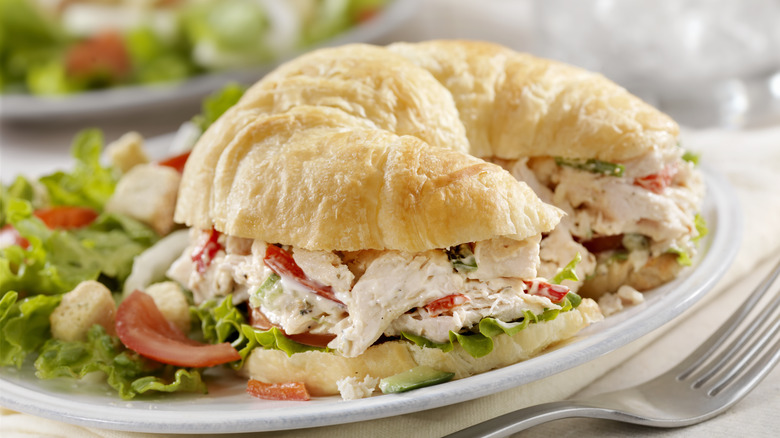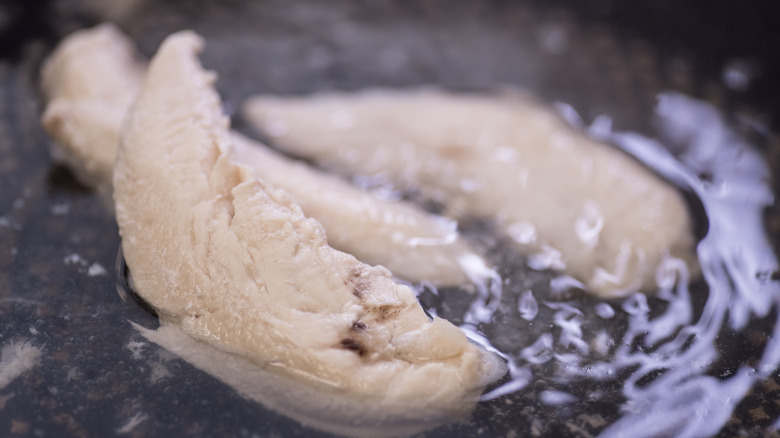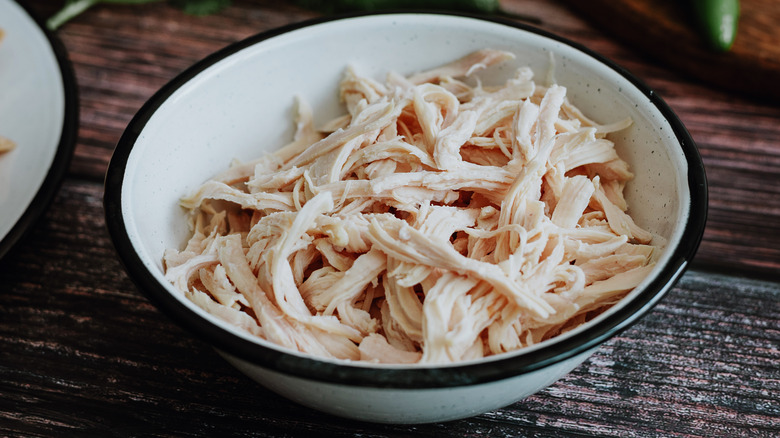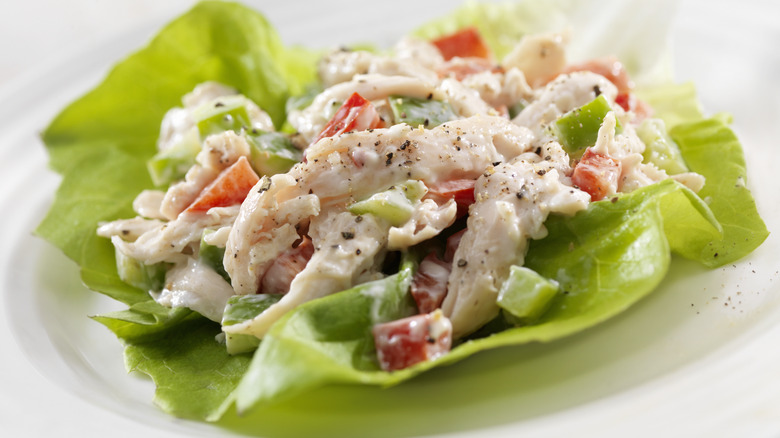How To Cook Chicken For The Tastiest Salads
Not many lunch or side dish options can compare to the creamy, savory flavors of a basic chicken salad recipe. Whether you're just using it as a sandwich filling or stuffing avocados with chicken salad as part of a recipe, this popular dish packs tons of protein and can easily be customized to your needs, making it an excellent choice for any home cook in need of a delicious meal.
Combined with a tart, oftentimes mayonnaise-based sauce and copious amounts of added ingredients, any basic chicken salad can transform into a mouth-watering meal. However, no amount of delicious dressing, seasonings, or crunchy mix-ins will cover up some poorly cooked poultry. To succeed in making this dish, you'll want to nail down how to pick, cook, shred, and incorporate your chicken into a delectable salad. You only need a little planning to avoid ending up with a tough, rubbery mess in the kitchen, so here's everything you should keep in mind when cooking chicken for your salads.
Choose the right cut of chicken
Before you even head to the kitchen and start cranking up the heat, you'll want to pick a piece of chicken that will not only shine in its taste but will not be a headache to shred. Skinned, boneless chicken breasts are generally your most convenient option. This lean protein will not make you pick out tough bones or mushy skin later on in the assembly process. These cuts are typically the most expensive at grocery stores, so feel free to pick bone-in chicken breast if you want to save a few bucks at the checkout line. While you'll have to discard the carcass at some point, the bones can actually enrich your chicken and broth with extra flavor during cooking.
While juicy and packed with flavor in other dishes, you'll want to stay away from dark cuts of chicken — such as the thigh — for salads, as their stronger flavor can easily overpower a mayonnaise dressing or vinaigrette. Some chicken salad recipes also call for leftover or store-bought chicken, and while incredibly convenient, remember that some pre-cooked birds are sold overcooked, dry, or with unnecessary additives.
Poach your chicken
Many home cooks prefer to roast or even sear their chicken breast for the additional crunch, but poaching remains, by far, the best method to prepare your poultry for this salad. When done properly, the poached breast becomes succulent and easy to shred — perfect characteristics for a smooth, uniform chicken salad base. You'll want to keep your water down to a simmer, as poaching deliberately uses low temperatures to keep delicate foods from overcooking. If your water is boiling, it's too hot, and your chicken may end up dry.
Before you submerge your chicken breast in hot liquid, you must remember to season and fortify your water. Much like pasta and other starchy ingredients, skipping this step will leave you with a flavorless lump of meat — so sprinkle in salt, pepper, and aromatics such as fresh herbs and carrots. If you opted for boneless breast or just want to enhance your salad's flavors even further, you can also use a broth or bouillon to take the taste of this dish to the next level. However, just water and salt are all you need to make your chicken salad shine.
Shred your chicken
Because you'll want your chicken salad to remain spreadable and able to be consumed without a knife, shredding is your best bet for uniform texture. However, how you go about cutting up your cooked breast really depends on your preferences. Shredding by hand or with two forks will give you the most control over how big your chicken shreds will turn out, but it can also take up a great bit of your time and leave you with a mess on the counter, or — worse yet — under your fingernails. A quick chop with a knife will also do the trick, but keep in mind that this will leave you with chicken chunks that will not adhere to your dressing as well as shreds.
If you want to have shredded chicken as part of your salad's texture but want to get things done fast, you can use a hand mixer or food processor to get those desired strips. You'll need to exercise caution when using machinery, as overmixing can easily result in your chicken turning into mince. Remember to remove all bones and undesirable bits (skin, connective tissue, etc.) out of your chicken before tossing it into the mixer as well since omitting this step can result in inedible bits of carcass making their way into your salad.
Let your chicken cool before mixing
You're almost done making your chicken salad! While you might be tempted to just toss everything together and serve it right away, a little patience goes a long way. If you're going the classic route and using mayonnaise as the lead ingredient in your dressing, tossing it alongside burning hot chicken can result in its emulsion breaking, which means a sad, split sauce.
Don't want to use mayonnaise as part of your dressing? Heavy cream is the only secret ingredient you need for creamier chicken salad – but sour cream or Greek yogurt also make great, dairy-based alternatives. Then, you can add whatever spices, seasoning, and crunchy vegetables (or fruit!) you want.
But even with a more heat-resistant dressing (such as a vinaigrette), chicken salads are traditionally eaten cold. Once mixed with your preferred sauce and other ingredients, let your chicken salad rest in the fridge for an hour or more to really soak up the sauce. This dish can safely be left refrigerated for up to four days, which should be more than enough time for it to chill and mix. Just remember to add a dash of citrus or vinegar before serving to brighten up your chicken salad's flavors and enjoy.





